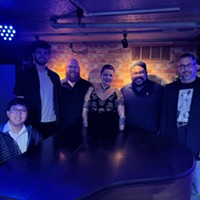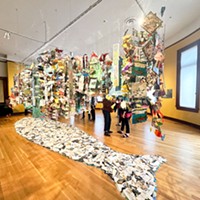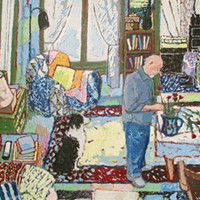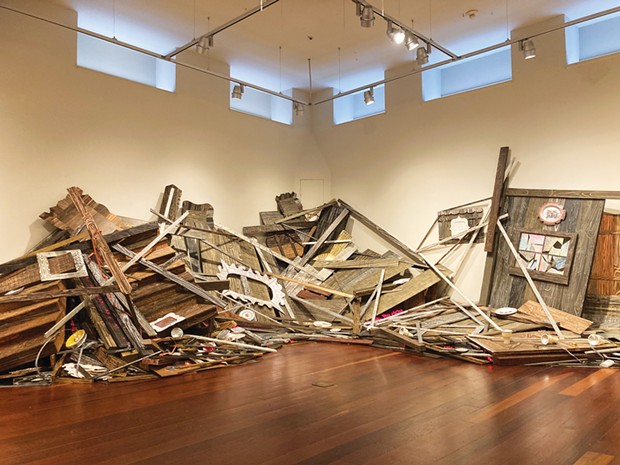Truth Units
Bachrun LoMele's Burn Pile/The Andromeda Mirage at the Morris Graves
By Gabrielle Gopinath[
{
"name": "Top Stories Video Pair",
"insertPoint": "7",
"component": "17087298",
"parentWrapperClass": "fdn-ads-inline-content-block",
"requiredCountToDisplay": "1"
}
]
Working for the past 15 years on the site of the former Synanon cult compound in the Sierra Nevada foothills, Bachrun LoMele has built his art practice into a self-perpetuating exploration of the vexed notion of personal truth. The artist solicits anonymous volunteers to record what they believe to be true statements in privacy. He then randomizes and rearranges those "truth units" before returning the reconstructed utterances to an audience in suggestive material form.
In LoMele's exhibition on view at the Morris Graves Museum of Art Sept. 2 through Oct. 15, a series of wall-mounted sculptures titled "Broken Words" frame remnant elements of signage from the walls of an abandoned Muslim elementary school once operated at the site of LoMele's studio by members of the Baladullah cult. Wall-mounted sculptures from another series, "The Understory," replicate objects of decor that would not be out of place in a middle-class home, school or small business: There are forms reminiscent of pallets, salvers, picture frames and a lectern. The central installation "Burn Pile" appears to be a haphazardly assembled jumble containing scrap lumber, industrial track lighting strips, deconstructed sections of staircase and LED channels crawling with messages in red lettering. All these materials are shoved high against the space's back wall, like a pyramid of waste bulldozed by a FEMA cleanup crew.
Faux wood paneling and fussy decorative contours conjure a small-town, cracker-barrel Americana, familiar to anyone who's ever stopped at a rural antiques mall. But these objects are post-use and the vision they sustained has been deconstructed. "Burn Pile" evokes the past-tense images whose production accompanies the quickening drumbeat of natural disasters on the nightly news. Similar piles appear with ever-increasing regularity on our screens after the passage of hurricanes, tornadoes, flood and fire. What's on the burn pile? Materials and utterances from 21st century American homes.
Within the pile, surfaces that read initially as wood veneer resolve into a densely inscribed thicket of swirling patterns and lettering. Objects themselves fool the eye. Lengths of scrap wood, demolished staircase parts and lighting strips turn out to have been fabricated from papier-mache and other materials, as do the picture frames and serving platters. Every object is doubly loaded: firstly, with inscribed text and also with swirling patterns reminiscent of (but not identical to) wood grain. This swirling-pattern language, the artist has said, connotes the principle of flow.
The texts that appear illuminated in the installation's LED channels and inscribed on its surfaces are remixed compilations of statements LoMele solicited from anonymous "truth donors" via the interactive installation "Confidence Booth," which the artist exhibited at shopping malls, thrift stores, flea markets and public parks in the Sierra Nevada mountains and San Joaquin Valley. Volunteers were invited to record true statements inside a private, soundproof booth styled to look like a cozy living room. "I wanted it to look like grandma's house," the artist recalled. Then, a randomization algorithm scrambled the truths that have been harvested. The resultant hybrid utterances, machine-derived cut-ups have been divorced from obvious meaning. Resisting interpretation, they retain ghostly traces of intent, as well as a degree of structural and historic specificity — they're voiced in the past tense like remembered dreams, studded with Californian place names and proper nouns that gesture obliquely toward national headlines of the recent past. A papier-mache salver reads, in part: "It was Fresno. It was daylight. It was Epstein. It was him daylight possibility Cousteau. It was Fargo-to-Seven-Brother." Another piece is inscribed with the lines: "This is not the horror of this year's arrow./ one day flying through the epidemic in the shadows." You wouldn't mistake these fragments for truths universally acknowledged. Even so, a weird truth-y quality clings to them.
LoMele's approach recalls the stylings of Komar and Melamid, the post-Soviet conceptualists whose signature project remains their 1990s series People's Choice. In these works, the duo created nations' "most wanted" and "least wanted" paintings based on the results of surveys conducted by professional polling companies. The generally acknowledged aesthetic failure is the project's punchline, while gesturing at the inadequate binary nature of Cold War thought. In the same way, remixing volunteers' personal truths into authorless new configurations yields serendipitous vibes, even as it fails to generate veritas.
"Truth is like a thrashing-machine," Herman Melville observed in The Confidence-Man, "tender sensibilities must keep out of the way." On one level, "Burn Pile" telegraphs the difficulty of finding common ground in an era in which every truth is construed to be "personal," where post-truth politics and tender sensibilities hold sway. But LoMele's installation is not all Babel and nihilism. The artist states in a video narration that he aspires "to show respect for an ambient sincerity, free of specificity," wondering: "Can the apprehension of a greater truth, unknowable, oblique, arise from this?" The artwork might function like a compass, redirecting our perception of truth to a sector located elsewhere, where logic does not apply. If crowd-sourced truth nuggets fail to congeal into sense, this might tip viewers off to the fact that their search for truth was itself flawed — the question incorrectly framed. LoMele's sprawling project indulges our skepticism, while at the same time staking claim to the oxymoron hidden like a stiletto inside Bruce Nauman's neon catchphrase, "The True Artist Helps the World By Revealing Mystic Truths."
Burn Pile's claim to humanism is in its central insight: that truth is not the outcome of an equation's solution, or an essence to be distilled, but something essentially beyond us. This point hits different in the age of ChatGPT. The large language model neural networks and other artificial intelligence systems now beginning to shape our world are trained by trawling through billions of pages of text data indiscriminately scraped from the internet, employing a post-truth learning model that is alien to the human brain. Now that AI is casting horoscopes, writing state legislature housing bills, and designing weapons systems, will viewers laboring to wrap their heads around Burn Pile's koans conclude that the fault lies not in themselves, but in the algorithms?
Gabrielle Gopinath (she/her) is an art writer, critic and curator who lives in Arcata. Follow her on Instagram at @gabriellegopinath.
Speaking of Bachrun Lomele, Morris Graves Museum Of Art
-

Music Today: Sunday, Feb. 18
Feb 18, 2024 -

The Return of '30,000 Salmon'
Aug 17, 2023 -

Ruth Arietta's Illusory Interiors at Morris Graves Museum of Art
Aug 10, 2023 - More »
more from the author
-
Nancy Tobin's CRy-Baby Installation at CR
- Feb 22, 2024
- More »
































